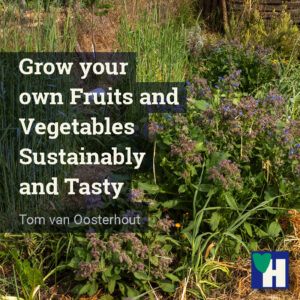
What motivates us to grow our own fruits and vegetables? The effort as such of course. The prospect of a harvest, no matter how modest. A green and at the same time colorful garden. Foods without poison. Improvement of the environment.
The fact that the exercise it takes to grow your own fruits and vegetables, in combination with the outdoor work, keeps you fit. Of course, the examples of others also motivate particularly well, because there is no motivation without inspiration.
In this article, I present some of the examples we know of. The aim is to inspire you to also grow your own fruits and vegetables.
Some of the links are affiliate links. As an affiliate associate, we earn a commission when you purchase any of the products offered through the shared links at no extra cost for you. This helps us maintain this website.
Table of contents
- 1 Grow your own fruits and vegetables
- 2 No motivation without inspiration
- 3 Green touch
- 4 Urban community gardens
- 5 Inspiring Spanish village gardens
- 6 Botanical gardens
- 7 We grow our own fruits and vegetables
- 8 Grow your own fruits and vegetables: a global movement
- 9 Join the Global Urban Gardening Movement
Grow your own fruits and vegetables
Grow your own fruits and vegetables and join the biggest world movement ever: the Global Urban Organic Gardening Movement. More and more people favor fruits, herbs, and vegetables fresh and healthy from their own gardens.
No motivation without inspiration
The green touch of our environment helps a lot. We live next to a nature park. Moreover, there are a lot of huertos (orchards) and campos de hortalizas (vegetable fields) here.
Botanical, community and urban agricultural gardens are also inspiring sources. A friend runs an organic fruits and vegetable shop in a village nearby and cultivates a lot of his produce on his own lands.
Recently we visited a group of young people that revive a huge tract of disused agricultural land.
Green touch
City nurseries, like city parks and graveyards and the trees on the sidewalks, are all maintained by local governments. They add the oh so necessary green touch to the modern cities that are dominated by stinky cans on wheels and horrendous concrete buildings. The challenge for us is to add to this green touch, and profit at the same time ourselves, by growing our own fruits and vegetables.
Urban community gardens
In my article ‘The Quality of Food Determines Life Expectancy’ I suggest growing your own fruits and vegetables with your neighbors. One example of this is here in Puerto de Mazarrón.
In 2008 the entire city of Todmorden in the UK turned into an agricultural garden with the Incredible Edible Todmorden project.
Urban community gardens create:
- Better physical and social quality in the neighborhood;
- Opportunities for unskilled workers, alternative care, nursery and recreation;
- Jobs for unskilled workers;
- And provide more production options for farmers.
Another example of an urban community garden is the Prinzessinnengärten in Berlin, Germany. There they integrate welfare, urban planning, and environmental politics.
When you’re blessed with a house with a garden, like us, you sometimes forget that people also live in apartment buildings (such as the apartments surrounding the Prinzessinnengärten). Although some people are very creative, there is hardly any room for a green touch. For people who live in apartment blocks, urban community gardens are a marvelous green opportunity.
Inspiring Spanish village gardens

On a regular basis, we travel through the beautiful Spanish countryside. Once out of the tourist routes we find the most beautiful, small, characteristic, and idyllic villages.
Most villages have a church, a plaza mayor with a bar or a restaurant, a convent of some sort, and a small village garden.
These gardens are always well kept and the fruits and vegetables are always abundant and look great. With the exception of the siësta hours, we often see an old man hoeing between the plants.
Someday soon, when our Spanish is adequate enough, we will try to tap into their undoubtedly vast agricultural knowledge.
Botanical gardens
Other inspiring examples are botanical gardens. When we travel we make an effort to visit as many botanical gardens as we can during holidays. This is a feat that I think is inspired by our frequent visits to Insel Hombroich in Germany. Although our first visit to the big California nature parks in 1991 might also have contributed substantially.
There are beautiful botanical gardens in Holland, such as the big glass Hortus in the middle of Amsterdam and the open-air Hortus in Leiden. In the village where we used to live there was also a small and very well-kept Hortus.
Here in Spain, the most beautiful botanical garden we visited is the one in Valencia. Although the botanical gardens in Cordoba and Malaga are also impressive. In general, many major cities with a university have botanical gardens.
But there are also more secluded ones. In the Comunidad Autónoma de Andalucia, there are 12 secluded botanical gardens. One of them is the Jardín Botánico Umbría de la Virgen near the small Village which is accordingly called Maria on the A317.
This botanical garden is one of Spain’s most important ones because it harbors a vast collection of the Quercus Ilex (evergreen oak, holly oak, or holm oak).
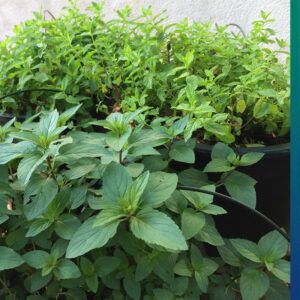
Most botanical gardens here in Spain are equipped with an agricultural garden. However, they probably are not meant to be seen by the visitors because there are never signs explaining the plants. With the exception of the botanical garden in Cordoba.
We grow our own fruits and vegetables
Our efforts to grow our own fruits and vegetables are modest. At the moment we have a few square meters for strawberries, tomatoes, and zucchini. We also have 3 lemon trees, an olive tree, and both a green and a black fig tree that all have difficulty growing up.
In several pots, we grow mint (two different types) for tea. You just clip a twig of some 10 centimeters, put the twig in a teacup, and pour some hot water on it. Delicious.
Grow your own fruits and vegetables: a global movement
I was very surprised to learn that the urban community gardens movement in the USA met with such heavy opposition by conservative politicians. In the mid-’90s, in New York, former mayor Rudy Giuliani planned to bulldoze dozens of urban agricultural gardens.

Fortunately, this had a counterproductive effect. The citizen’s consciousness was raised and turned urban gardening into a movement. Urban community gardens prove to fulfill an economic function because they provide cheap, fresh food that many people can’t afford. These gardens are also places of gathering, cooperation, and act as reciprocal education centers for people of different ages and cultures.
Join the Global Urban Gardening Movement
No matter how modest our efforts are, we’re very proud that so far we have succeeded in rearing at least some fruits and vegetables. We are dedicated to participate with so many other people in the Global Urban Organic Gardening Movement.
Related: Healthy Lifestyle: What are the Lifetime Benefits of Organic Food
If you’re also proud of your kitchen garden or if you participate in an urban agricultural garden project, or you know any urban community initiatives or botanical gardens you like, please send us your pictures and stories, and, if available, a cross-reference on the Internet. We’ll be very grateful and will share the results.
Do you have a kitchen garden? Let us know in the comment box below.

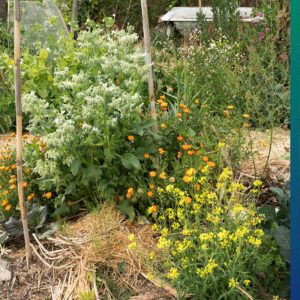
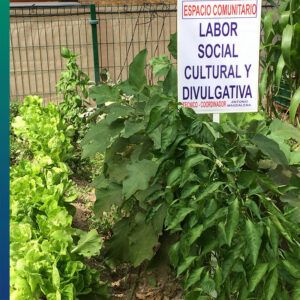
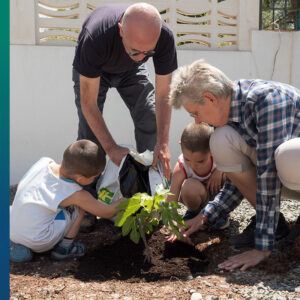
Nice, for the first time we haven our OWN tomatoes.
Wow!! Do they taste good?
It’s such a marvelous feeling, isn’t it, when you can harvest edibles from your own garden. We are lucky enough to be able to have several planting seasons over here. And although we have to get used to a different kind of soil than we had in the Netherlands and way different temperatures, it is still very gratifying to grow stuff.
Wow, I didn’t know that urban community gardens even exist. That’s a great way of connecting people and somehow forcing them to grow plants and eat healthier. I lived in a house with a big garden, but now I live in an apartment.
We don’t have a garden, the only place where I could grow some plants is on my balcony. What do you think, what are the best plants I could grow there? I was thinking of some smaller plants, so I still have enough space to sit on the balcony, drink coffee in the morning, and sometimes make a BBQ.
Hi Petar,
Thanks for your comment. On your balcony growing plants largely depends on the amount of sun the balcony takes on an average day. The more sun, the more chances of success.
The plants that take up the least space, usually are herbs. Such as rosemary, basil, coriander, tarragon, chives, thyme. Although thyme is a more difficult plant because it needs less water and a more specific type of soil, so it’s best grown in a different plant pot.
Here in Spain, we buy our seeds from two voluntary associations that are specialized in organic seeds. And we only use organic soil.
When you grow plants on your balcony it is also important to grow plants that get flowers, such as lavender. This attracts bees that will pollinate your plants. This is necessary when you grow for instance paprikas or tomatoes. By the way, paprika and tomato plants don’t take up much space either.
Good luck with your balcony garden.
For now, stay safe, stay healthy.
Regards,
Tom
Excellent article Tom.
Here in Canada, some communities have what we call community gardens where you can plant a little block of the garden for your family.
At our oldest granddaughters’ high school, they grow a vegetable garden and the school cafeteria uses the produce to make the school lunches.
The students look after the garden and learn about nutrition and where food comes from.
Personally, we have always had a garden and are so fortunate that we grow a wide variety of fruits and vegetables which I can and freeze for use in winter.
Our youngest son lives in an apartment and he grows tomatoes and leaf lettuce on his balcony in summer.
Great article Tom.
Some communities here in Canada have community gardens where families can grow some vegetables.
Our oldest granddaughters high school grows a vegetable garden. The students plant and grow the plants and when harvested the school cafeteria uses that produce in lunches for the students.
I love this program as it teaches the kids where their food comes from.
We are fortunate to live in a rural community and have the room to grow plenty of fruits and vegetables. I can and freeze plenty of vegetables for use in the winter.
Our youngest son successfully grows lettuce and tomatoes on the balcony of his apartment. While he doesn’t have the space to grow all of his food, he can certainly grow some which is so satisfying.
Thanks for this great article.
Hi Deb,
Community and school gardens are a blessing. Although the history behind their revival is not a happy story.
During wartime governments always urge the citizens to grow their own food, because of distribution problems. In rural areas, this is hardly sound advice. In cities with many apartment buildings, there is not enough space. So, city parks changed into community gardens.
With the crisis, starting in 2008, many citizens lost their job and got into serious financial problems. This prompted them to start growing food in abandoned building areas or at the outskirts of cities. Fortunately, the gardens didn’t disappear. In the current pandemic crisis, they still come in handy.
Here in Spain, there are hardly any community gardens. Most families share a bit of land somewhere. Just as they often share a second or third house or apartment. Because the land is usually not close by enough to grow fruits and vegetables that take a lot of attention, most of these small patches of land have olive, lemon, orange, or mandarin trees.
During the lockdown, many of the fruits could not be harvested. A sad sight, all the fruits rotting away on the land. Nevertheless, this is also a kind of community type of garden.
Thank you for your comment and compliments.
For now, stay safe, stay healthy.
Regards,
Tom
Hi Tom, Hi Hannie,
I love your post on growing your fruits and vegetables. I have tried to do so in our tiny garden, but I need more compost to develop them more significantly. We make our compost; that is fun.
However, we are terrorized by an army of snails that love our vegetables, even our citrus tree. That is the reason I stopped the project again, now only growing herbs. But I would love to grow my vegetables again. It tastes so amazing. I do have lettuce, but in pots and hanging, so snails can’t get to them.
They love tomatoes too! We were thinking of growing a vegetable garden on our flat roof, but snails come there as well.
I love the idea of an urban vegetable garden sharing with our neighbors. These are great projects, so we have our vegetables and help the bees and bumblebees, butterflies, and other insects to increase in number again. Maybe a board: ” Snails are not welcome! ” would help! 😉
Hi Sylvia,
Depending on the size of your garden you should put one or two plates with beer between the plants on the ground. Snails love beer. They crawl into the plate, drink the beer, get drunk and drown. You’ve got to check the plate regularly and refresh the beer when needed.
Of course, a sign ‘No Snails Allowed’ is always better. The funny thing is, snails can read. However, they’re naughty and always in need of glasses. Although I think that they just cannot resist the lovely fresh greens in your garden. And snails don’t discriminate, they eat any vegetable available.
Compost is usually not enough to fertilize your kitchen garden. You should also add some cow, goat, or horse manure. Preferably organic. When you have a small garden, stop planting anything after two years and leave it to rest for a year.
Don’t forget to put plants in your garden that grow flowers. Such as lavender. To attract bees and butterflies. That reminds me, there are birds that eat snails. Like blackbirds, crows, seagulls, and magpies. They hack the shells. For them, snails are a real treat.
Lots of luck with your kitchen garden.
Stay safe, stay healthy.
Regards,
Tom